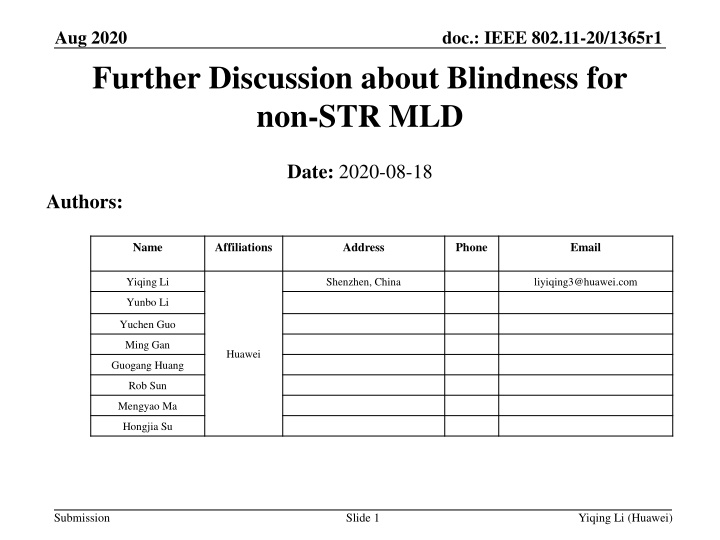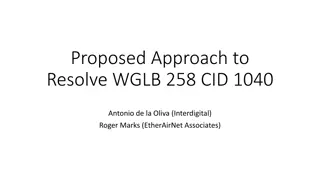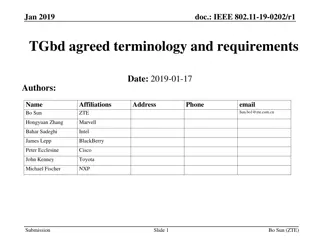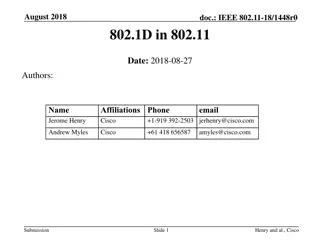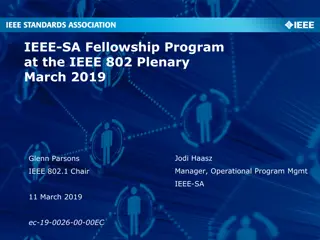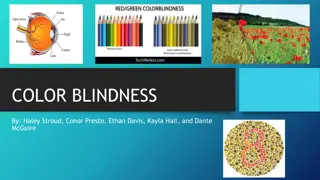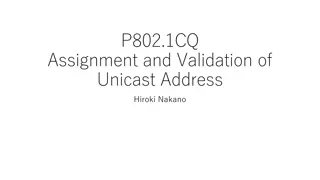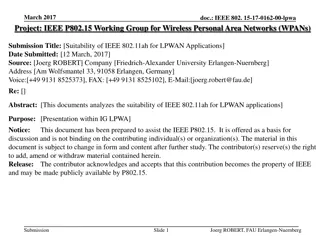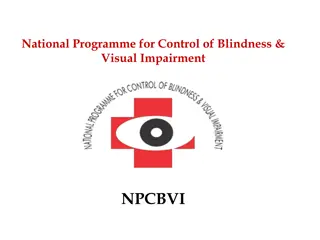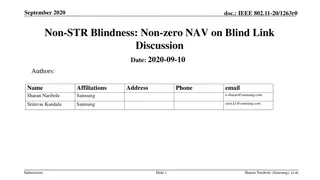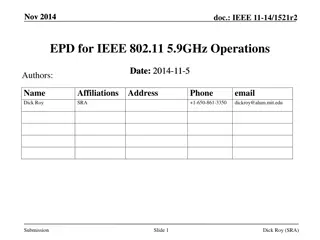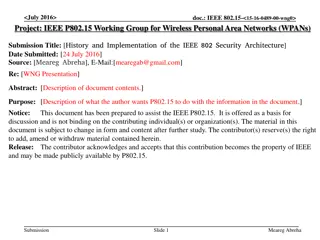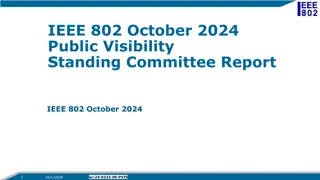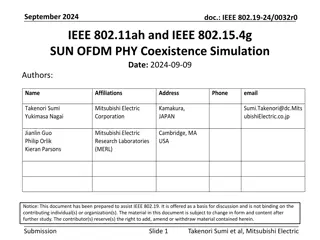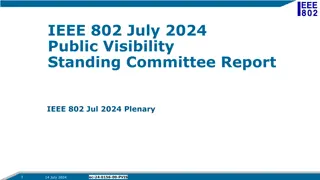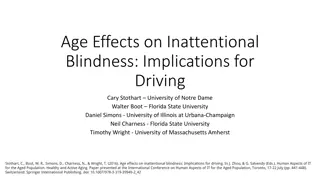Handling Blindness Issue in MediumSyncDelay for IEEE 802.11-20/1365r1
Discussion on mitigating the blindness issue at non-STR non-AP MLD side focusing on introducing a MediumSyncDelay parameter and decreasing ED threshold. Solutions proposed to avoid collisions during RTS transmission in scenarios where STAs are hidden from each other.
Download Presentation

Please find below an Image/Link to download the presentation.
The content on the website is provided AS IS for your information and personal use only. It may not be sold, licensed, or shared on other websites without obtaining consent from the author.If you encounter any issues during the download, it is possible that the publisher has removed the file from their server.
You are allowed to download the files provided on this website for personal or commercial use, subject to the condition that they are used lawfully. All files are the property of their respective owners.
The content on the website is provided AS IS for your information and personal use only. It may not be sold, licensed, or shared on other websites without obtaining consent from the author.
E N D
Presentation Transcript
doc.: IEEE 802.11-20/1365r1 Aug 2020 Further Discussion about Blindness for non-STR MLD Date: 2020-08-18 Authors: Name Affiliations Address Phone Email Yiqing Li Shenzhen, China liyiqing3@huawei.com Yunbo Li Yuchen Guo Ming Gan Huawei Guogang Huang Rob Sun Mengyao Ma Hongjia Su Submission Slide 1 Yiqing Li (Huawei)
doc.: IEEE 802.11-20/1365r1 Aug 2020 Motivation How to handle the blindness issue at non-STR non-AP MLD side is discussed in [1]; There are three main points Introduce a MediumSyncDelay parameter Decrease the ED threshold, [-82dBm, -62dBm] Allow to transmit limited times of RTS while MediumSyncDelay timer is running Allow RTS transmission while MediumSyncDelay timer is running will be risk in certain case, it should be avoided. Submission Slide 2 Yiqing Li (Huawei)
doc.: IEEE 802.11-20/1365r1 Aug 2020 Issues to Tx RTS in MediumSyncDelay It is a typical scenario that AP3 in link2 can be heard by STA2, but STA3 (associated with AP3) is hidden from STA2; After the blindness period, channel will be busy for STA2 due to the transmission of PPDU3, but when PPDU3 is finished, STA2 will sense the channel becomes idle; If STA2 start to backoff, and transmit RTS, it will collide with BA from STA3 to AP3; The standard should avoid it happens. PPDU1 from STA1 to AP1 STA1 AP1 link1 MediumSyncDelay Non-AP MLD AP MLD Blindness period RTS from STA2 to AP2 AP2 link2 CCA busy STA2 Interference to BA3 BA3 from STA3 to AP3 PPDU3 from AP3 to STA3 AP3 link2 STA3 Submission Slide 3 Yiqing Li (Huawei)
doc.: IEEE 802.11-20/1365r1 Aug 2020 Solution 1: Disallow backoff in EIFS A potential solution 1 is that if the channel is busy right after the blindness period base on the ED sensing results, STA2 is not allowed to backoff within EIFS time; So it will leave time for STA3 to transmit BA3 to AP3; If there are following PPDU4 from AP3 after BA3, STA2 will decode PPDU4 to set NAV. PPDU1 from STA1 to AP1 STA1 AP1 link1 MediumSyncDelay Non-AP MLD AP MLD Blindness period AP2 link2 CCA busy EIFS STA2 BA3 from STA3 to AP3 PPDU3 from AP3 to STA3 AP3 link2 STA3 Submission Slide 4 Yiqing Li (Huawei)
doc.: IEEE 802.11-20/1365r1 Aug 2020 Solution 1: Disallow backoff in EIFS No matter STA3 is hidden or not, disallow backoff within EIFS following a immediate busy will not hurt the system performance For the case that STA3 is hidden from STA2, it is the scenario we want to protect STA3 s transmission For the case that STA3 is not hidden from STA2, STA2 will set NAV by BA3 from STA3, and MediumSyncDelay time expires. The channel busy may caused by Wi-Fi signal or non-Wi-Fi signal. Since it is hard to distinguish them when preamble is missed, it is better to treat them as Wi-Fi signal; Solution 1 is preferred. PPDU1 from STA1 to AP1 STA1 AP1 link1 MediumSyncDelay Non-AP MLD AP MLD Blindness period AP2 link2 CCA busy EIFS STA2 BA3 from STA3 to AP3 PPDU3 from AP3 to STA3 AP3 link2 STA3 Submission Slide 5 Yiqing Li (Huawei)
doc.: IEEE 802.11-20/1365r1 Aug 2020 Solution 2: Disallow backoff in MediumSyncDelay Solution 2 is to disallow backoff in within the MediumSyncDelay period; It is a more conservative solution, which is not so necessary; Solution 2 is not preferred. PPDU1 from STA1 to AP1 STA1 AP1 link1 MediumSyncDelay Non-AP MLD AP MLD Blindness period Backoff Disallow AP2 link2 CCA busy STA2 BA3 from STA3 to AP3 PPDU3 from AP3 to STA3 AP3 link2 STA3 Submission Slide 6 Yiqing Li (Huawei)
doc.: IEEE 802.11-20/1365r1 Aug 2020 Summary Allow RTS transmission while MediumSyncDelay timer is running will be risk if the channel is busy right after the blindness period base on the ED sensing results, the standard should avoided it happens. Two potential solutions are provided, and solution 1 is preferred Solution 1: disallow backoff in EIFS Solution 2: disallow backoff in whole MediumSyncDelay Submission Slide 7 Yiqing Li (Huawei)
doc.: IEEE 802.11-20/1365r1 Aug 2020 Straw Poll 1 Do you agree that if the channel is busy right after the blindness period base on the ED sensing results, a STA that affiliate with a NSTR MLD is not allowed to backoff within EIFS time? It is for R1. Y/N/A Submission Slide 8 Yiqing Li (Huawei)
doc.: IEEE 802.11-20/1365r1 Aug 2020 Reference [1] 11-20-1009-01-00be-multi-link-hidden-terminal-followup Submission Slide 9 Yiqing Li (Huawei)
